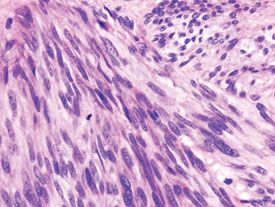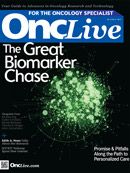Publication
Article
Oncology Live®
PERSONALIZED CANCER CARE5 Key Areas Where Biomarkers Point the Way to Personalized Care
Author(s):
Biological markers that help clinicians choose which treatment options to pursue for particular patients are attracting increased research interest.

Histopathologic image of gastrointestinal stromal tumor of the stomach. Hematoxylin-eosin stain.
The strategy of using targeted therapies to attack tumors has demonstrated signifi cant results in the past decade, and biological markers that help clinicians choose which treatment options to pursue for particular patients are attracting increased research interest.
Here is a summary of 5 key areas in which biomarkers are either already in clinical use or are showing promise as future signposts.
HER2
Established Breast Cancer Marker Explored
Human epidermal growth factor receptor 2, also known as HER2/neu (ERBB2), is a receptor tyrosine kinase that helps regulate cell survival and proliferation. Extra copies of the HER2 gene are found in 20% to 25% of breast cancers, and they cause excess production of HER2, prompting tumors to grow faster and recur more frequently. Overexpression of HER2 also occurs in some ovarian, stomach, lung, and uterine cancers.
HER2 bulges outside affected cancer cells rather than hiding inside, making it a good target for drugs. Trastuzumab (Herceptin) binds with HER2, suppressing the HER2 gene, reducing HER2 production, and blocking signaling pathways. The drug, which is being studied for use in other HER2-positive cancers, also promotes immune response, stimulating the body to attack cancers directly.
Another HER2-targeting drug is lapatinib (Tykerb), a dual tyrosine kinase inhibitor that disrupts different cell signaling pathways. Unlike trastuzumab, lapatinib is a small molecule that can cross the blood-brain barrier for cancers that have spread there. It binds to mutated HER2, where the receptor does not protrude properly from the cell.
Another monoclonal antibody, pertuzumab, which inhibits dimerization of HER2 with other HER receptors, is in advanced clinical trials. Genentech, a member of the Roche Group, recently announced that the pivotal phase III CLEOPATRA trial demonstrated that the combination of pertuzumab and Herceptin plus docetaxel chemotherapy significantly improved progression-free survival compared with Herceptin and docetaxel alone for patients with HER2-positive metastatic breast cancer.
The targeted agents are not likely to be effective against breast cancers that do not exhibit an excess of HER2, nor are they effective in all HER2-positive cases. Patients are screened for potential eligibility through immunohistochemistry and either silver, chromogenic, or fluorescence in situ hybridization. tiny.cc/yfprf, gene.com
GIST
Disease State Linked to Several Genes
Gastrointestinal stromal tumors (GISTs), which are newly diagnosed in 3000 to 6000 people in the United States annually, are associated with several different oncogenes and proteins that can help improve diagnosis and determine treatment for individual patients.
About 85% of all GIST cases can be attributed to 2 types of mutations: a mutation in the KIT gene and a mutation in platelet-derived growth factor receptor alpha (PDGRFα).
Mutations in the KIT gene, whose protein products are KIT or CD117, are observed more frequently than the PDGRFα mutation, being found in 80% to 85% of all GIST cases. The most common of those mutations generally respond well to treatment with imatinib (Gleevec), though secondary mutations are often spotted after patients develop resistance to that drug.
Mutations in PDGFRα occur in about 5% of all GIST cases. Of the 4 common mutations, only the PDGFRα exon 18 mutation in GIST (D842V) confers lowered responsiveness to standard treatments, most often imatinib.
Mutations in BRAF—a serine/threonine protein kinase involved in cell proliferation, differentiation, and transcriptional regulation—are rare but deadly. They occur in less than 1% of cases but carry an increased risk of malignancy and resistance to existing KIT/PDGFRα tyrosine kinase inhibitors.
For the approximately 10% to 15% of patients whose GIST tumors show no abnormalities in any of these proteins, treatment with sunitinib (Sutent), which is the second-line treatment for most GISTs, has been demonstrated to be effective in 1 of 3 patients who are resistant to imatinib.
Other targeted therapies that have been tested against different types of GIST include sorafenib (Nexavar), nilotinib (Tasigna), and dasatinib (Sprycel). tiny.cc/zeou1, tiny.cc/pa0i3, tiny.cc/6wjgg
EGFR
Protein Emerges as Target, Particularly in Lung Cancer
Epidermal growth factor receptor, also known as ERBB1 or HER1, is a cell-surface receptor protein that is frequently found to be mutated and overactive in lung cancer, colorectal cancer, and glioblastoma multiforme.
EGFR exists on the cell surface and is activated by binding of its ligands, including epidermal growth factor and transforming growth factor. Mutations involving EGFR can lead to its constant activation and bring about uncontrolled cell division.
EGFR protrudes from cells enough to make it an attractive binding target for drugs that prevent activation or binding with other cells and stop the cycle of dysfunction. Panitumumab (Vectibix) was approved in 2006 for the treatment of colorectal cancer. Cetuximab (Erbitux) is another EGFR-inhibiting antibody that is also approved for colorectal cancer and for treatment of squamous cell carcinoma of the head and neck.
Gefitinib (Iressa) and erlotinib (Tarceva) are EGFR inhibitors approved for use against lung cancer. Lapatinib targets both EGFR and HER2 and is often used in combination with trastuzumab in treating breast cancer. These last 3 agents are all small-molecule medications rather than antibodies, so they can be taken as pills rather than injected.
In April, the American Society of Clinical Oncology issued a provisional opinion about how EGFR testing should guide treatment choices for patients with advanced adenocarcinoma non-small cell lung cancer (NSCLC).
Patients whose tumors test positive for EGFR gene mutations have higher response rates to erlotinib and gefitinib while tumors that test negative exhibit better responses to standard chemotherapy. Earlier this year, the National Comprehensive Cancer Network similarly called for EGFR testing of patients with NSCLC tumors of all histologies except squamous cell carcinoma.
Pharmaceutical companies hope to win approvals for new indications of existing drugs and bring new EGFR inhibitors to market to fight other cancers. Most other cancers do not have EGFR as the sole regulator in certain downstream pathways found in breast cancer and lung cancer, so they are resistant to the effects of EGFR inhibitors. tiny.cc/srx7p, tiny.cc/tea8c

KIT
Mutations Found in Many Tumor Types
Overexpression of the protein products of the KIT gene (KIT or CD117) has been associated with GISTs, testicular seminoma, mast cell disease, melanoma, acute myeloid leukemia, and thymic malignancies. KIT molecules normally live on the outside of various cells, especially hematopoietic stem cells, and serve to identify those cells to antibodies and to communicate with other cells. Mutations of the KIT gene or overexpression of the molecule occur at varying rates in different cancers.
Five separate types of KIT mutations are found in GIST, collectively appearing in about 85% of all cases. KIT is overexpressed in 87% of thymic malignancies, enough that it might be used in diagnosis to distinguish them from thymoma or lung carcinoma.
Many cancers with KIT mutations or overexpression respond well to imatinib, which is now approved for use against 10 cancers, with more tests underway. For patients with imatinib-resistant KIT-positive leukemia, there is the kinase inhibitor nilotinib.
Another antibody that inhibits KIT is pazopanib (Votrient), which was approved for the treatment of renal cell carcinoma 2 years ago. Pazopanib may also be effective in ovarian cancer, soft tissue sarcoma, and NSCLC. The small-molecule KIT inhibitor suntinib is approved as a treatment for renal cell carcinoma, as a second-line medication for GIST, and in advanced pancreatic neuroendocrine tumors. tiny.cc/xrara
KRAS
Activity Attracting Keen Research Interest
This protein, encoded by a gene of the same name and designed to serve as a molecular on/off switch, mutates in some people to increase the virulence of certain cancers and decrease the efficacy of targeted medications.
Under normal circumstances, the KRAS protein is involved in regulating cell division. Mutations of the gene are associated with lung adenocarcinoma, colorectal carcinoma, mucinous adenoma, and ductal carcinoma of the pancreas.
The role of KRAS in colorectal cancer has attracted the greatest interest to date, because it can help determine whether patients will respond to a pair of treatments that inhibit EGFR, which is amplified in many cases of colorectal cancer. Panitumumab and cetuximab have produced striking results against many of those cancers. KRAS, however, may work to reduce the effectiveness of either drug and worsens colorectal cancer results by nearly every metric. The activating mutations that predict poor performance—at least 17 distinct mutations have been noted—occur in about 40% of colorectal cancers.
Approximately 15% to 25% of patients with lung adenocarcinoma also have KRAS mutations. Those mutations are shown to reduce or eliminate responses to the EGFR tyrosine kinase inhibitors erlotinib and gefitinib, but it has not been shown whether they reduce response to antibody-based EGFR inhibitors. tiny.cc/633t5
Cancer Biomarkers
There is no single regulatory repository for information about cancer biomarkers. US regulatory procedures for approving biomarker tests vary depending upon whether the test is to be sold as a product or a laboratory service; the only FDA-approved biomarkers available for clinical use are protein molecules.1
This list consists of FDA-approved and other clinically used biomarkers compiled from the sources cited below.
Biomarker
Cancer Type
Clinical Use
Alfa-fetoprotein2-4
NSGCT, HCC
Diagnosis, staging, detecting recurrence, monitoring
BTA2
Bladder
Monitoring
Calcitonin3
Medullary, thyroid carcinoma
Diagnosis, monitoring
CA1252-4
Ovarian
Prognosis, detecting recurrence, monitoring
CA15-32-4
Breast
Monitoring
CA19-92-4
Pancreatic
Monitoring
CA27-292,4
Breast
Monitoring
CEA2-4
Colon
Monitoring, prognosis, detecting recurrence, screening for hepatic metastases
Chromosomes 3,7,9, and 172
Bladder
Screening, monitoring
Cytokeratins2
Breast
Prognosis
EGFR2
Colon, NSCLC†
Selection of therapy
ER and PgR2,3
Breast
Selection of therapy
Fibrin/FDP2
Bladder
Monitoring
HE44
Ovarian
Monitoring
HER2/neu2-4
Breast
Prognosis, monitoring, selection of therapy
High molecular weight CEA and mucin2
Bladder
Monitoring
Human chorionic gonadotropin-β2,3
Testicular
Diagnosis, staging, detecting recurrence, monitoring
KIT2
GIST
Diagnosis, selection of therapy
LDH3
Germ cell
Diagnosis, prognosis, detecting recurrence, monitoring
NMP222
Bladder
Screening, monitoring
Pap smear2
Cervical
Screening
PSA2-4
Prostate
Screening, monitoring, diagnosis (with DRE)
Tg2-4
Thyroid
Monitoring
†NSCLC testing recommendations in National Comprehensive Cancer Network guidelines and American Society of Clinical Oncology provisional opinion.
NSGCT indicates nonseminomatous germ cell tumor; HCC, hepatocellular carcinoma; BTA, bladder tumor-associated antigen; CA, cancer antigen; CEA, carcinoembryonic antigen; EGFR, epidermal growth factor receptor; NSCLC, non-small cell lung cancer; ER, estrogen receptor; PgR, progesterone receptor; FDP, fibrin degradation protein; HE4, human epididymis protein 4; GIST, gastronintestinal stromal tumor; LDH, lactate dehydrogenase; NMP22, nuclear matrix protein 22; PSA, prostate-specific antigen; DRE, digital rectal exam; Tg, thyroglobulin.
- Mishra A, Mukesh V. Cancer biomarkers: are we ready for the prime time? Cancers. 2010; 2:190-208. doi:10.3390/cancers2010190.
- Ludwig JA, Weinstein JN. Biomarkers in cancer staging, prognosis and treatment selection. Nat Rev Cancer. 2005;5(11):845-856.
- Kulasingam V, Diamandis EP. Strategies for discovering novel cancer biomarkers through utilization of emerging techologies. Nat Clin Pract Oncol. 2008;5(10):588-599. Doi:10.1038/ncponc1187.
- Rhea JM, Molinaro RJ. Cancer biomarkers: surviving the journey from bench to bedside. Med Lab Obs. 2011; 43 (3):10-18.
Biomarkers on Drug Labels
Information about pharmacogenomic biomarkers is included on various sections of the labels of more than 70 drugs, including 19 oncology drugs. The FDA Website carries a table at http://tiny.cc/hymf9.









